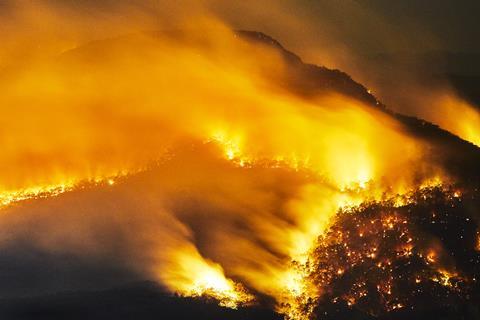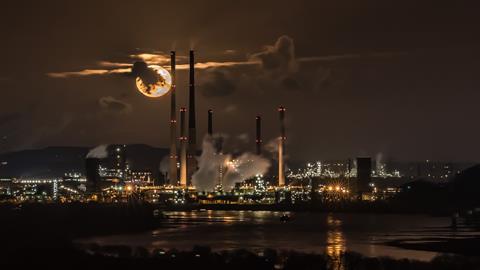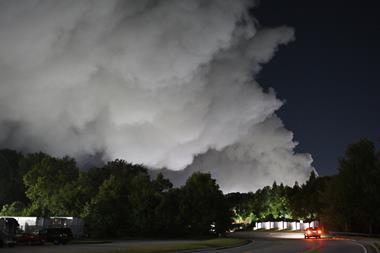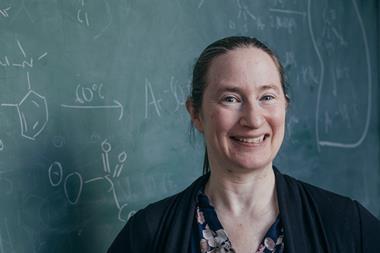Pollutants, key atmospheric components and vital fertilisers: nitrogen compounds are all of these, as Emma Davies finds out
Nitrogen oxides (NO and NO2; NOx) have a bad press, particularly in the wake of the vehicle emissions scandal. But they are just a small part of a highly complex nitrogen cycle, which controls a vast range of atmospheric processes, many of which are linked to climate change and adverse human health effects. From agricultural ammonia emissions to cars belching NOx, the cycle has been studied in a fragmented way but there are now calls to unite researchers to help deliver what policy-makers need to know.
Although many aspects of the cycle are well understood, night-time chemistry has been somewhat neglected. The Earth’s atmospheric chemistry changes dramatically as the air cools and the sun’s photochemistry fades away. Because longer-lived chemicals created in the hours of darkness fall down to the surface the following day, understanding night-time mechanisms could help with policies to cut damaging levels of nitrogen-based pollutants that cause adverse health effects, from heart disease to respiratory illness.
During the day, surface heating results in convective currents that give a deep boundary layer, where the air is well mixed and easy to sample for chemical analysis. As night falls, and the Earth’s surface cools, the atmosphere splits to give a very shallow boundary layer. The air that was mixed during the day stays above the stable boundary layer in a residual layer.
In the dark
‘A lot of atmospheric chemistry in the field in the past 30–40 years has focused on daytime chemistry. Night-time chemistry is a bit harder to look at,’ says Pete Edwards from the Wolfson atmospheric chemistry laboratory at the University of York in the UK.
Together with Steve Brown from the US National Oceanic and Atmospheric Administration Earth System Research Laboratory (NOAA ESRL) in Colorado, Edwards has measured how chemicals released from plants react with coal-fired power plant emissions in the south-east US during the hours of darkness.

Forests release high volumes of volatile organic compounds, such as isoprene (2-methyl-1,3-butadiene) and monoterpenes. Meanwhile, the power plants inject their NOx directly into the night-time residual layer. Despite falling anthropogenic emissions of sulfur dioxide and NOx, the region still has a problem with ozone and particles, which is a bit of a mystery.
‘In terms of isoprene emissions, it’s like being in the Amazon,’ says Edwards. During the day, up to 90% of isoprene rapidly oxidises to form ozone and secondary organic aerosols, such as organic nitrates, which export up to 30% of anthropogenic NOx out of the boundary layer. Meanwhile, ozone and nitrogen dioxide also react to form nitrate (NO3) radicals, which rapidly photolyse in the daytime but become the dominant oxidants by night.
The research team flew a NOAA plane packed with instruments in the residual layer near a power plant ‘plume’, before moving downwind. The power-plant measurements appear to suggest far higher nitrate aerosol yields than predicted from previous experiments carried out in large chambers, says Edwards. ‘Laboratory studies suggest that the nitrate reaction with isoprene may be a much more efficient way to make particulate matter,’ adds Brown. If this is the case, then the reaction may be a large source of organic aerosols from isoprene, compared with photochemistry. ‘That process is not included in many air quality models or climate models right now,’ he adds.
The ultimate aim is to improve our representation of things that affect air quality and climate
The team suspects that the region’s night-time oxidation is at a mechanistic ‘tipping point’ and beginning to be dominated by ozone rather than NOx. But the actual mechanisms remain somewhat shrouded.
Brown is keen to carry out a similar study in China, which has both large biogenic emissions and significant anthropogenic releases, including increasing NOx levels. ‘I think that chemistry is very much understudied and that would be a frontier area where more of the research that we did in the southeast US would be interesting and, I would argue, necessary.’
Particulate matter is a regulated secondary pollutant that affects human health, says Brown. ‘We need more data to characterise the rates and yields of all of the relevant processes so that those models can more accurately predict how much particulate matter comes from the night-time side of atmospheric chemistry.’
The researchers hope to use new mechanistic understanding to help policy and future emission scenarios, says Edwards. ‘The ultimate aim is to improve our representation of things that affect air quality and climate, two of the main societal challenges. In terms of the general nitrogen cycle, particulate matter has a huge impact on nitrogen deposition, which also affects fertilisation of the oceans and land. It all feeds into the nitrogen question.’
Chamber of secrets

This summer, Edwards and Brown travelled to the Jülich Research Centre in Germany to revisit chamber experiments using the institution’s Saphir (simulation of atmospheric photochemistry in a large reaction chamber) facility, in the hope of revealing detailed chemical mechanisms for the reaction between the NO3 radical and isoprene. In the chamber, they are able to control the types of radicals present, as well as radical intermediates.
Such lab studies in giant, sealed chambers help to unravel mechanisms but they are not perfect. A lot of the nitrogen-based chemicals are quite ‘sticky’ and can be lost to the walls. In the past, when measurement techniques were not as sensitive, experiments were often done at high concentrations. ‘What has now become apparent is that those high concentrations very much change the chemistry, because the lifetimes of reactive species are much shorter, which means that they don’t necessarily undergo the same reactions as they would in the atmosphere,’ says Edwards.
What helps is the fact that instrumentation is far more sensitive than it was 10 years ago, with techniques such as chemical ionisation time-of-flight mass spectrometry really helping to study highly functionalised organic nitrogen compounds. Meanwhile scientists are also able to define the limitations of these chamber studies. These days, teams are likely to use the same instruments in the chamber and the field to allow direct comparisons. ‘I think that the interaction between chamber and field studies represents the new frontier in developing a mechanistic understanding for some of these systems,’ says Brown.
Despite uncertainties arising from their assumptions, computer modelling is essential. For detailed chemistry, researchers tend to use so-called box models, which ignore the effects of meteorology, dynamics, and emissions. But simulating air quality in a city requires much bigger 3D models that replicate the movement of air mass. Such computationally intensive models require simplified chemistry.
Fire, fire
Brown is also using the same approaches to study the atmospheric chemistry of biomass fires in the western US, as part of a NOAA project called Firex (Fire Influence on Regional to Global Environments Experiment). Firex looks at emissions, as well as formation mechanisms for secondary species such as organic aerosols. Fire is important for many ecosystems but also poses obvious risks to human health and property. Recent years have seen an increase in frequency and duration of forest fires all over the globe.

In 2016, Firex ran a lab study in a Forestry Service facility, lighting fires at the base of a large indoor chimney, with tubes extracting smoke samples and sending them to lab instruments, including a proton-transfer-reaction mass spectrometer. The study identified many previously unknown volatile and semi-volatile compounds in wildfire smoke.
In 2019, the project will conduct a large-scale coordinated intensive field study using one large converted Nasa DC-8 airliner as well as a couple of smaller NOAA aircraft. ‘We hope to get in as close as they will let us,’ explains Jim Roberts, an atmospheric research chemist at NOAA ESRL. He hopes to be able to make observations from 30 minutes after a fire starts burning to several days later. ‘The nitrogen part of the emissions is very interesting,’ he says. The wild fires are not hot enough to make NOx from the air’s nitrogen and oxygen, unlike cars or power plants, he explains. Instead, all of the nitrogen comes from the fuel. At intermediate temperatures you get isocyanic acid (HNCO) and hydrogen cyanide, both of which cause inflammatory responses in human lungs, while low temperature compounds include ammonia and amines.
During a fire you can get very different kinds of emissions that would lead to different kinds of atmospheric chemistry
Results from the fire lab study and simulation chambers will be used together with data from the field mission in 2019 to improve modelling and air quality forecasting. By measuring compounds as a function of temperature, the team can begin to make important generalisations, says Roberts. ‘The models are important because we can’t measure every fire but we need to be able to understand what the impact will be on air quality. We think we have a good set of observations that will allow us to do that and we will be able to confirm that with our measurements next summer.’
‘Biomass burning is the most variable emission source on the planet,’ says Brown. There is also a big difference between a smouldering biomass emission and a flaming one. ‘Within a course of hours or minutes during a fire you can get very different kinds of emissions that would lead to different kinds of atmospheric chemistry, so it’s a very complicated problem.’
And results from a 2016 US field study led by Matthew Coggon from the University of Colorado suggest that higher nitrogen fuel content gives higher emissions of nitrogen-containing volatile organic compounds. The emissions of compounds hazardous to human health, such as isocyanic acid and hydrogen cyanide, and the formation of secondary pollutants, are likely to depend on fuel nitrogen, the researchers suggest.
Smoke from residential wood fires generally contains less nitrogen than crop and grass fires but nitrogen compounds released can vary even within a single plant, says Coggon. The researchers suggest that acetonitrile (CH3CN), commonly used as a tracer, may not be suitable for domestic burning in urban areas. Instead, wood burning emissions may be best identified by analysing an emissions profile rather than relying on a single tracer, they say.
Roberts is keen to delve into the relationship between exposure to fires’ nitrogen compounds and health outcomes. He hopes to set up a collaboration with researchers that can study health effects to match his team’s expertise in measurements and chemistry. ‘We need to talk about this as a community,’ he says.
International rescue
Mark Sutton from the Centre for Ecology and Hydrology in Edinburgh, UK, also hopes to build a nitrogen community. ‘I think the interesting thing in terms of understanding with the nitrogen cycle is often that we will know the principles of relationships, but quantitatively how they fit together will be poorly known – simply because many scientists have worked in a fragmented way across the cycle,’ he says. Getting people to work more closely together is a challenge but ‘each nitrogen issue on its own is often not enough to drive change’.
Sutton specialises in atmospheric ammonia, which has a very short atmospheric lifetime but reacts with acids to form particulate matter that constitute health-damaging particles below 2.5µm in size.
Each nitrogen issue on its own is often not enough to drive change
He chairs the International Nitrogen Initiative (INI), a global network of scientists linking research to policy, with a goal to ‘stimulate’ global nitrogen science networking. Together with the United Nation’s Environment Programme, INI have launched a project ‘towards the International Nitrogen Management System (INMS)’, which aims to bring together the scientific community, private sector and society to gather evidence to support international policy to improve global nitrogen management. With six regional centres representing Africa, Europe, Latin America, North America, South Asia and East Asia, INI hopes to optimise nitrogen’s beneficial role in sustainable food production while minimising its negative effects on human health and the environment.
The intention is to collect enough evidence to ‘showcase’ the need for effective practices for global nitrogen management, largely in agriculture. INMS is also intended to ‘stimulate regional assessment to put together a global nitrogen pollution status for informed policies on its management’, explains Nandula Raghuram from Indraprastha University in India, who will become chair of INI in 2019.
The INI also contributes to the task force on reactive nitrogen of the UN Economic Commission for Europe, established under its Geneva Air Convention. It aims to encourage coordination of air pollution policies on nitrogen in the context of the nitrogen cycle. For Sutton, this means studying the relationship between ammonia and the rest of the nitrogen cycle to look for the ‘win–wins’ for farmers and the environment.
With India’s levels of nitrogen pollution soaring, Raghruam co-founded the Indian nitrogen group, which has found that 65% of the nitrogen used in India as fertilisers may be leaking into the environment.
Ammonia alert

Most European farmers use ammonium nitrate fertilisers, with a historical link to Norwegian firm Norsk Hydro (now Yara), which first made them in 1905 using N2 and an electrical spark. Such nitrates don’t give much ammonia to the atmosphere. However, the rest of the world generally uses urea-based fertilisers, which are cheap to produce but release very high levels of ammonia. Although urea is probably only 10% of European fertiliser use, it accounts for at least 50% of ammonia emissions from fertilisers, says Sutton.
It is possible to reduce ammonia emissions from urea using chemicals that inhibit ammonia-releasing urease enzymes, ubiquitous in bacteria and plant leaves. ‘The big question at the moment is not a technological challenge but a societal and economic one because companies are marketing the products at extra cost,’ he says.
In a 2015 bid to cut environmental ammonia releases, the Indian government made it compulsory to coat agricultural urea with oil from the evergreen neem tree. The jury is out on whether the neem has the desired effect but India’s agricultural ministry reports positive results, with an increase in farmers’ returns thanks to rising crop yields and lower levels of urea usage.
Together with Raghuram, Sutton co-heads a UK–India virtual centre called Newton–Bhabha, which researches optimising nitrogen use for crop production in India. Sutton’s team has just finished a field project to quantify nitrogen fluxes in Indian rice fields. He battled significant logistical challenges, including having to ship in urea labelled with nitrogen-15, before finding a location to mill it into pellets. The researchers spent six months setting up a field site in north-east India to monitor ammonia releases, testing out different techniques. The results have yet to be published but Sutton is relieved to find out that standard cuvette techniques for measuring direct ground emissions appear to be more or less accurate. ‘The numbers we are getting from the field trials are not a million miles off for ammonia and it’s giving us a basis to say how different agronomic treatments are working.’
Sutton believes that research and policy are coming together. ‘Our science work is feeding into the policy arena but those discussions with policy-makers in better understanding the barriers to change also feed back to change our research agenda.’
Emma Davies is a science writer based in Bishop’s Stortford, UK













No comments yet